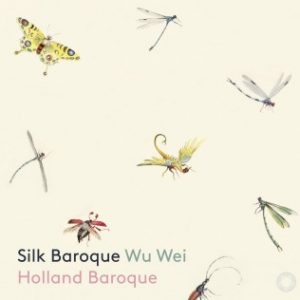 Holland Baroque is het innoverende ensemble dat samen met de Chinese topmusicus Wu Wei het album ‘Silk Baroque’ opnam. Een CD die verwijst naar de Zijderoute (Silk Route). Een handelsroute tussen China en het westen die tot in de late Middeleeuwen zorgde voor een handelsverbinding tussen Oost en West die nu buitengewoon fraai muzikaal wordt vertaald.
Holland Baroque is het innoverende ensemble dat samen met de Chinese topmusicus Wu Wei het album ‘Silk Baroque’ opnam. Een CD die verwijst naar de Zijderoute (Silk Route). Een handelsroute tussen China en het westen die tot in de late Middeleeuwen zorgde voor een handelsverbinding tussen Oost en West die nu buitengewoon fraai muzikaal wordt vertaald.
English version below
Wu Wei is een meestermusicus uit China die de sheng bespeelt. Een eeuwenoud mondorgel, de voorloper van onze accordeon. Daarnaast bespeelt Wu Wei de bawu (dubbelriet instrument) en de erhu, die vergelijkbaar is met onze viool. Deze wordt rechtop bespeeld, heeft 2 snaren en kent vele varianten, zoals de Mongoolse horsfiddle of de Iranese kamenche.
Het Holland Baroque orkest staat onder leiding van Judith en Tineke Steenbeek, respectievelijk op viool en clavecimbel/orgel. Zij stellen zich tot doel de Barokmuziek te vertalen naar het heden. Dat doen ze op fabelachtige wijze op hun nieuwe album ‘Silk Baroque’. Geen enkel werk is pure barokmuziek zoals we dat gewend zijn. Nee, steeds wordt de muziek aangepast, herschreven, gearrangeerd of worden er zelfs delen toegevoegd. Zo is het openingswerk ‘What about some bells’ (met een muzikale zeefdruk van de klokken van de Big Ben) van Judith Steenbeek gelardeerd met muziek van Telemann. Er klinkt een transparante bewerking van ‘Tristes Apprèts’ uit de opera ‘Castor et Pollux’ van J.P. Rameau met toevoeging van de sheng. Het overbekende stuk ‘La Follia’, dat gebaseerd is op een akkoordenreeks met melodie en door zeer veel componisten is bewerkt, horen we op ‘Silk Baroque’ in een bewerking van Vivaldi, aangevuld met Wu Wei op de sheng. Maar ook staan er enkele Chinese werken op deze bijzondere CD. Werken die doorspekt zijn met westerse muziek zoals ‘Chaos for Wu Wei’ en ‘Dancing song of the Yao Tribe’ met de zo gebruikelijke pentatoniek: de 5-toonstoonladder die veel voorkomt in de Chinese muziek maar ook te vinden is in de Gospel, Noord-Afrikaanse muziek en de blues. Een hoogtepunt is het werk ‘Silk Rondeau’ (van Judith Steenbeek) dat met zijn herhalende melodie heerlijk zwierend door de kamer danst gevolgd door de prachtig ‘Gavotte’ (ook een dans) van de Franse componist J.M. Leclair. ‘Silk Baroque’ is een van de meest innoverende albums van de laatste tijd: verrassend, eigengereid, kleurrijk en fantastisch uitgevoerd!
English version
Holland Baroque is the innovative ensemble that recorded the album ‘Silk Baroque’ together with the Chinese top musician Wu Wei. A CD that refers to the Silk Route. A trade route between China and the West that, until the late Middle Ages, ensured a trade connection between East and West. Now exceptionally beautifully musically translated.
Wu Wei is a master musician from China who plays the sheng. An age-old mouth organ, the precursor of our accordion. In addition, Wu Wei plays the bawu (double reed instrument) and the erhu, which is comparable to our violin. This instrument is played upright, has 2 strings and has many variants, such as the Mongolian horsfiddle or the Iranian kamenche.
The Holland Baroque orchestra is led by Judith and Tineke Steenbeek, respectively on violin and harpsichord / organ. In a fabulous way they translate Baroque music into the presenton on their new album ‘Silk Baroque’. No composition is pure baroque music. The music is rewritten, arranged or even musical parts are added. For example, the opening piece ‘What about some bells’ (with a soft voices Big Ben sound) by Judith Steenbeek is interlaced with music from Telemann. There is a transparent adaptation of ‘Tristes Apprèts’ from the opera ‘Castor et Pollux’ by Rameau with the addition of the sheng. The well-known piece ‘La Follia’, based on a series of chords and melodie and edited by many composers, can be heard on ‘Silk Baroque’ in an arrangement by Vivaldi, supplemented with Wu Wei on the sheng. But there are also some Chinese works punctuated with western music such as ‘Chaos for Wu Wei’ and the amazing piece ‘Dancing song of the Yao Tribe’, with the usual pentatonic: the 5-tone scale that is common in Chinese music but can also be found in Gospel, North African music and the blues. A highlight is ‘Silk Rondeau’ (by Judith Steenbeek). A lovely dancing tune with a repeating melody, followed by the beautiful ‘Gavotte’ (also a dance) by the French composer J.M. Leclair. ‘Silk Baroque’ is one of the most innovative albums of recent times. Surprising, colourful and played and arranged by fantastic musicians!
- Holland Baroque / Wu Wei: ‘Silk Baroque’ (Pentatone)

Geen reacties